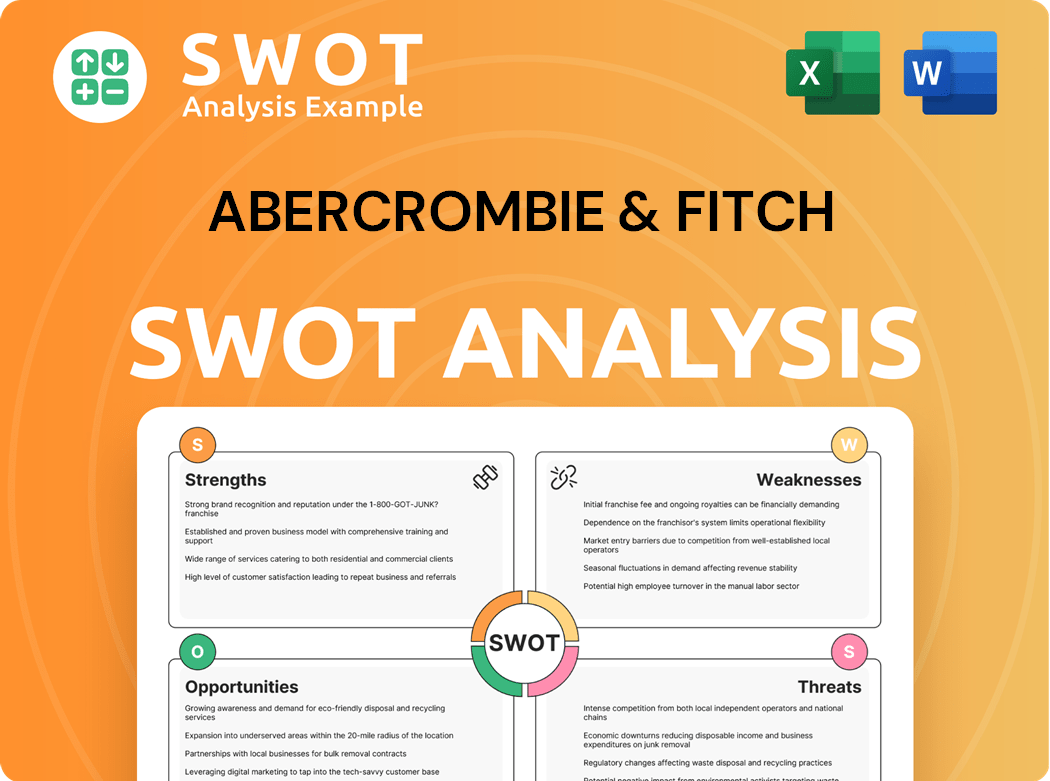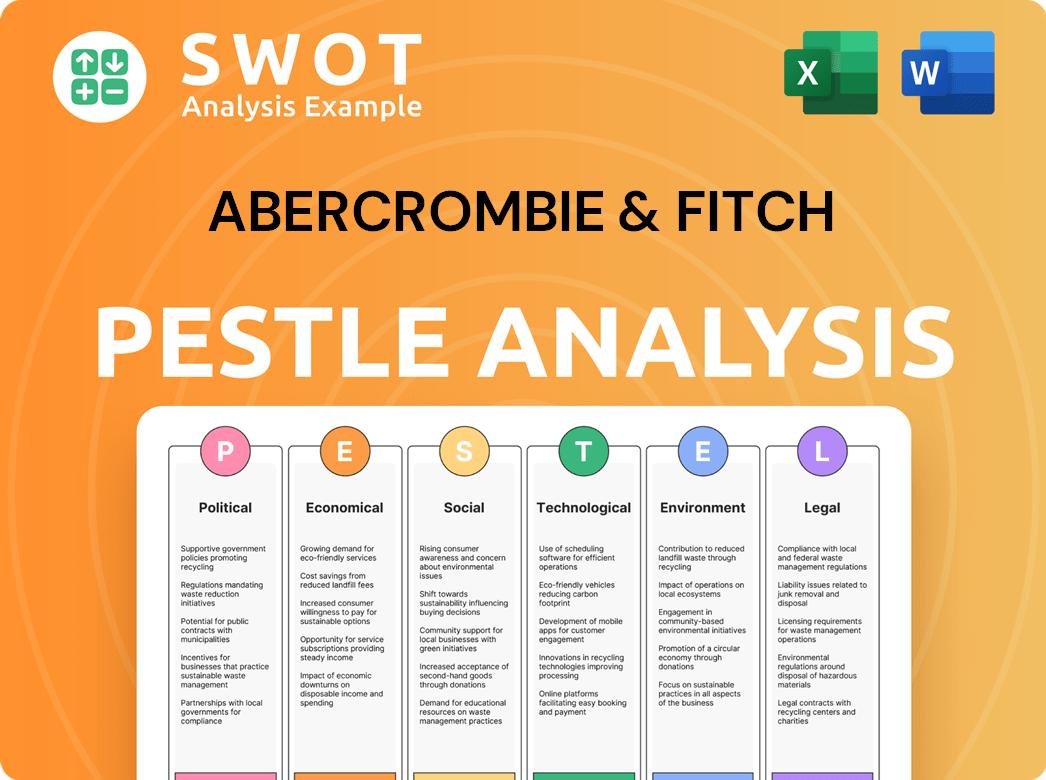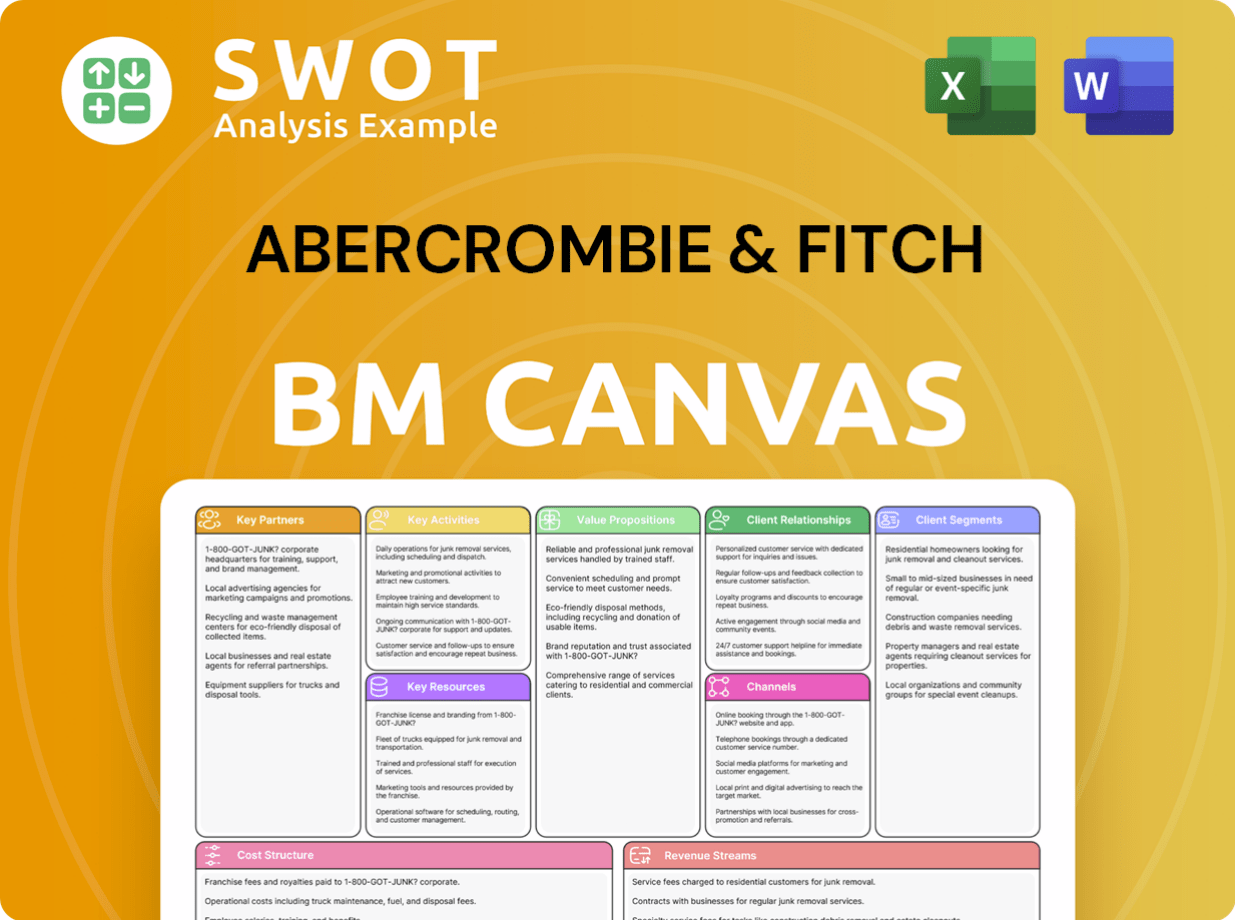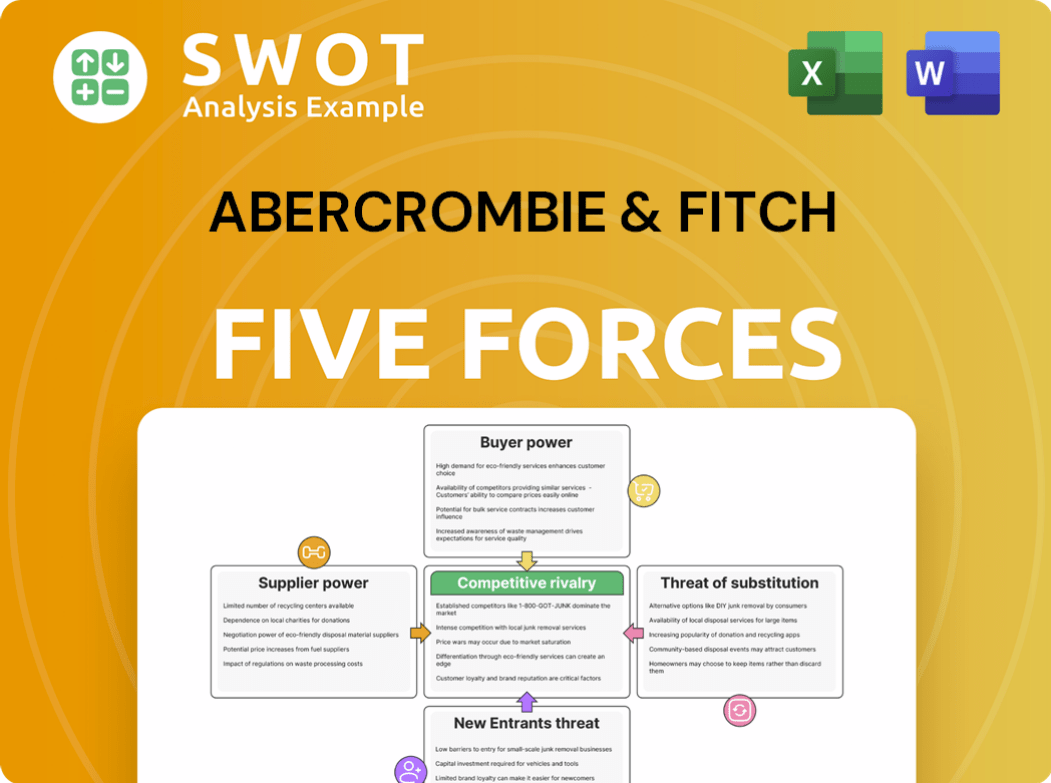Abercrombie & Fitch Bundle
How Did Abercrombie & Fitch Transform Over Time?
Journey back in time to explore the fascinating Abercrombie & Fitch SWOT Analysis, a brand that has experienced a remarkable transformation. From its roots as a purveyor of high-end outdoor gear, the of Abercrombie & Fitch company is a captivating tale of evolution and reinvention. Discover the pivotal moments that shaped this iconic brand and its enduring presence in the fashion world.

Understanding the and its history provides valuable insights into the dynamic nature of the retail industry. This exploration of the
What is the Abercrombie & Fitch Founding Story?
The Growth Strategy of Abercrombie & Fitch began with a vision rooted in the outdoors. The Abercrombie & Fitch company, a name synonymous with a certain era of fashion, has a history that stretches back to the late 19th century. This is a story of how the A&F brand came to be.
The Abercrombie & Fitch founding date was June 4, 1892. David Abercrombie, a man with a background in the outdoors, established Abercrombie Co. in Manhattan, New York. His focus was on providing high-quality gear for outdoor enthusiasts.
Ezra Fitch joined the company in 1900. The company was then renamed Abercrombie & Fitch Co. in 1904. The initial business model was to sell upscale sporting goods. The early product lines included tents, fishing rods, and other outdoor equipment. Abercrombie & Fitch's evolution saw the company experiment with different approaches to reach a wider audience.
Abercrombie & Fitch's journey began in 1892 with David Abercrombie and evolved through a partnership with Ezra Fitch.
- David Abercrombie founded Abercrombie Co. in 1892.
- Ezra Fitch became a partner in 1900, leading to the company's renaming in 1904.
- Abercrombie left the company in 1907 due to differing visions.
- The early focus was on high-quality outdoor and sporting goods.
Abercrombie & Fitch SWOT Analysis
- Complete SWOT Breakdown
- Fully Customizable
- Editable in Excel & Word
- Professional Formatting
- Investor-Ready Format

What Drove the Early Growth of Abercrombie & Fitch?
Following David Abercrombie's departure, the company's growth continued under Ezra Fitch, marking the 'Fitch Years.' This period saw the expansion of the Abercrombie & Fitch product line and its rise as a prominent retailer. The company's evolution included significant expansions and shifts in its target market. The brand's history is marked by periods of success and challenges, reflecting broader trends in the fashion industry.
In 1910, Abercrombie & Fitch began offering women's clothing, becoming a pioneer in coed sporting attire in New York. The company moved to a 12-story building on Madison Avenue in 1917, which included various departments, such as a shooting range. The catalog's popularity grew, reaching a global audience. This expansion broadened the company's appeal and solidified its position in the market.
The brand outfitted notable figures like President Theodore Roosevelt and Charles Lindbergh, which enhanced its reputation. The company supplied military equipment and uniforms during wartime. This association with prominent figures and wartime efforts boosted the brand's image and market reach. The brand's association with adventure and leadership was a key part of its identity.
The company achieved a record profit of $682,894 in 1947, but faced challenges later. The brand struggled to adapt to changing market trends and competition. This led to financial difficulties, resulting in Chapter 11 bankruptcy protection in 1976. The New York flagship store closed in 1977, marking a significant turning point in the A&F history.
Oshman's Sporting Goods purchased the brand in 1978, initially reviving it as a mail-order business. The Limited acquired Abercrombie & Fitch in 1988, moving the company to Columbus, Ohio. Under Mike Jeffries, CEO in the 1990s, the brand shifted to a 'casual luxury' image, targeting young adults. This rebranding was a pivotal moment in the Abercrombie & Fitch timeline.
Abercrombie & Fitch PESTLE Analysis
- Covers All 6 PESTLE Categories
- No Research Needed – Save Hours of Work
- Built by Experts, Trusted by Consultants
- Instant Download, Ready to Use
- 100% Editable, Fully Customizable

What are the key Milestones in Abercrombie & Fitch history?
The A&F history is a story of evolution, marked by significant milestones and shifts in strategy. From its early days as a purveyor of sporting goods to its later transformation into a youth-oriented brand, the Abercrombie & Fitch company has experienced periods of growth, controversy, and reinvention. Understanding the Abercrombie & Fitch timeline is key to appreciating its journey within the history of fashion brands.
| Year | Milestone |
|---|---|
| Early 1900s | Founded as a sporting goods retailer, catering to an elite clientele. |
| 1990s | Rebranded under Mike Jeffries, shifting to a youth-oriented casual luxury lifestyle. |
| 1998 | Abercrombie Kids launched, expanding the brand's portfolio. |
| 2000 | Hollister Co. launched, targeting a younger demographic. |
| 2010s | Faced declining sales and controversies related to exclusionary marketing. |
| 2017-Present | Undertook a major rebranding effort, focusing on inclusivity and diversity. |
A&F history includes several innovative strategies that shaped its identity. The company's early adoption of a mail-order catalog expanded its reach. Later, it pioneered a distinct store experience and marketing aesthetic, which became widely recognized.
Early on, the company utilized a mail-order catalog to broaden its customer base beyond its physical store location.
The brand created a unique store environment, characterized by specific music, scents, and lighting, to enhance the shopping experience.
Abercrombie & Fitch developed a distinctive marketing approach, including the use of attractive models and provocative imagery, to resonate with its target audience.
The launch of Abercrombie Kids and Hollister Co. expanded the brand's reach to different demographics.
Recent efforts include enhanced digital capabilities, such as a more user-friendly website and improved online shopping experiences.
The company has focused on improving its supply chain to reduce costs and increase responsiveness to market trends.
The A&F brand has faced significant challenges throughout its history. The brand's exclusionary marketing and alleged discriminatory hiring practices led to significant criticism and lawsuits. Furthermore, the company faced challenges related to product failures, a toxic corporate culture, and an inability to adapt quickly to changing fashion trends and the rise of fast fashion retailers. You can learn more about the competitive landscape in Competitors Landscape of Abercrombie & Fitch.
The brand's marketing, which often featured a specific body type and image, alienated many potential customers and led to criticism.
The company faced lawsuits and criticism regarding its hiring practices, which were alleged to be discriminatory.
The brand struggled to adapt quickly to changing fashion trends and the rise of fast-fashion retailers, impacting sales.
The brand experienced product failures, which negatively affected customer satisfaction and brand reputation.
The company faced challenges related to a toxic corporate culture, which affected employee morale and productivity.
Increased freight costs present a challenge to maintaining profitability and growth momentum.
Abercrombie & Fitch Business Model Canvas
- Complete 9-Block Business Model Canvas
- Effortlessly Communicate Your Business Strategy
- Investor-Ready BMC Format
- 100% Editable and Customizable
- Clear and Structured Layout

What is the Timeline of Key Events for Abercrombie & Fitch?
The A&F history is marked by periods of significant change and adaptation, from its origins as an outfitter for the elite to its later transformation into a youth-focused brand. The Abercrombie & Fitch company has navigated bankruptcy, ownership changes, and evolving consumer preferences, ultimately aiming for sustainable growth in the competitive retail market.
| Year | Key Event |
|---|---|
| 1892 | David Abercrombie founded Abercrombie Co. in New York City. |
| 1900 | Ezra Fitch became a partner, and the company was renamed Abercrombie & Fitch Co. in 1904. |
| 1907 | David Abercrombie left the company. |
| 1917 | The company moved to a 12-story building on Madison Avenue. |
| 1976 | Abercrombie & Fitch filed for bankruptcy. |
| 1978 | Oshman's Sporting Goods acquired the Abercrombie & Fitch name. |
| 1988 | The Limited (later L Brands) purchased Abercrombie & Fitch and began repositioning it as a youth retailer. |
| 1992 | Mike Jeffries became CEO, focusing the brand on the teen market. |
| 1998 | Abercrombie Kids was launched. |
| 2000 | Hollister Co. was launched. |
| 2014 | Mike Jeffries stepped down as CEO. |
| 2023 | Full-year net sales reached $4.3 billion. |
| 2024 | Full-year net sales reached $4.95 billion, a 16% increase from 2023. |
| 2025 | The company expects net sales growth of 3% to 6% and plans to open 60 new stores. |
The 'Always Forward' strategic plan aims to reach $5 billion in sales. This plan involves maintaining brand relevance and executing growth strategies across different regions.
For fiscal year 2025, the company anticipates net sales growth between 3% and 6%. An operating margin between 12.5% and 13.5% is also expected.
Approximately 60 new store openings are planned for 2025. The company is investing in omnichannel capabilities to enhance the customer experience.
The company focuses on sustainable, profitable growth and adapting to the environment. A $1.3 billion share repurchase authorization highlights its financial strength.
Abercrombie & Fitch Porter's Five Forces Analysis
- Covers All 5 Competitive Forces in Detail
- Structured for Consultants, Students, and Founders
- 100% Editable in Microsoft Word & Excel
- Instant Digital Download – Use Immediately
- Compatible with Mac & PC – Fully Unlocked

Related Blogs
- What is Competitive Landscape of Abercrombie & Fitch Company?
- What is Growth Strategy and Future Prospects of Abercrombie & Fitch Company?
- How Does Abercrombie & Fitch Company Work?
- What is Sales and Marketing Strategy of Abercrombie & Fitch Company?
- What is Brief History of Abercrombie & Fitch Company?
- Who Owns Abercrombie & Fitch Company?
- What is Customer Demographics and Target Market of Abercrombie & Fitch Company?
Disclaimer
All information, articles, and product details provided on this website are for general informational and educational purposes only. We do not claim any ownership over, nor do we intend to infringe upon, any trademarks, copyrights, logos, brand names, or other intellectual property mentioned or depicted on this site. Such intellectual property remains the property of its respective owners, and any references here are made solely for identification or informational purposes, without implying any affiliation, endorsement, or partnership.
We make no representations or warranties, express or implied, regarding the accuracy, completeness, or suitability of any content or products presented. Nothing on this website should be construed as legal, tax, investment, financial, medical, or other professional advice. In addition, no part of this site—including articles or product references—constitutes a solicitation, recommendation, endorsement, advertisement, or offer to buy or sell any securities, franchises, or other financial instruments, particularly in jurisdictions where such activity would be unlawful.
All content is of a general nature and may not address the specific circumstances of any individual or entity. It is not a substitute for professional advice or services. Any actions you take based on the information provided here are strictly at your own risk. You accept full responsibility for any decisions or outcomes arising from your use of this website and agree to release us from any liability in connection with your use of, or reliance upon, the content or products found herein.